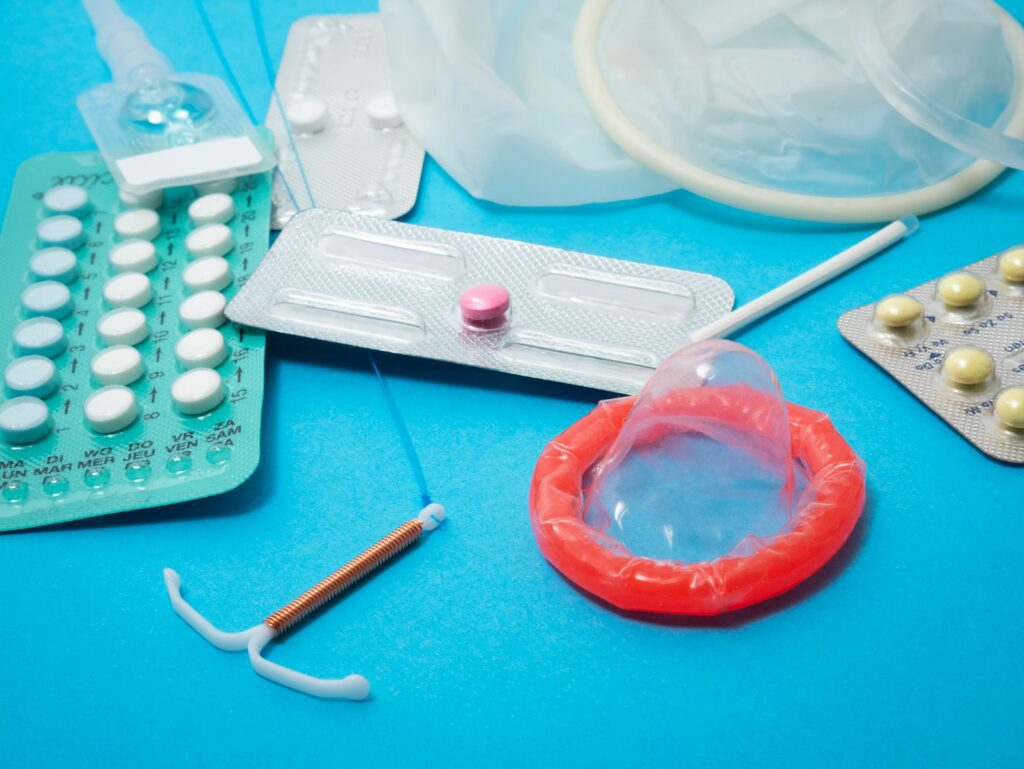
Women’s Resource Center believes in making informed decisions, especially when it comes to sexual health and pregnancy. That’s why we provide comprehensive education on pregnancy, abortion, and reproductive health options, including morning-after pills and contraceptives.
Before you decide on a type of contraception or fertility awareness method, take the time you need to research all the options, including failure rates, STD protection, miscarriage rates, and cancer risks involved.
No contraceptive method is foolproof. If you think you may be experiencing an unexpected pregnancy, make an appointment today. All services are confidential and at no cost to you.
Barrier Contraceptives
This line of contraceptives can:
- Help protect against STDs
- Stop sperm from entering the vagina
However, any barrier methods may tear or come off during sex,which can greatly increase your risk of contracting an STD or becoming pregnant.
Male Condoms
Male condoms have a failure rate of approximately 14%. That means 14-15 people out of every 100 will become pregnant during the first year of use. The most common types are made of latex, which can cause an allergic reaction for some people.
Female Condoms
Female condoms can be inserted into the vagina at least eight hours before sexual intercourse. They are slightly more expensive than male condoms. When used consistently and correctly, they are 95% effective against pregnancy and STDs. If not, they have a failure rate of approximately 16%.
Diaphragm or Cervical Cap
Made of soft silicone, it is moderately effective. Diaphragms are usually more effective when they are used with a spermicide.
The typical failure rate is about 17%.
Sponge
A small donut-shaped device made of polyurethane foam that is coated with spermicide, it is usually inserted into the vagina before sexual intercourse. It should be left intact for at least 6 hours after. The use failure rate of this method differs in mothers and non-mothers; it is between 14-27%.
Hormonal Methods
This method prevents conception by preventing the egg from being fertilized. Estrogen and progestin are typically the hormones that are involved. They usually prevent pregnancy by:
- Stopping the release of eggs
- Thickening the cervical mucus
Oral contraceptives do not protect against STDs and should be avoided in women who smoke or have a history of blood clots.
They are also classified as group 1 carcinogens and can increase your cancer risk.
Side effects vary by the type of hormone method, but common side effects for these methods include, but are not limited to, blood clots, depression and mood changes, fainting, acne, hives, hot flashes and hormonal imbalances, weight gain, and more. Like any drug, women react differently based on their health conditions and sensitivities.
Intrauterine Device (IUD)
A small T-shaped device, there are two types of IUDs, the Levonorgestrel intrauterine system (LNG IUD) and the Copper T intrauterine device (IUD). An IUD is placed inside the uterus by a doctor. It releases a small amount of progestin each day to keep you from getting pregnant. The LNG IUD stays in your uterus for up to 3 to 8 years, depending on the device. Typical use failure rate: 0.1-0.4%. The Copper T IUD can stay in the uterus for up to 10 years and the failure rate is 0.8%.
Implant
A small flexible plastic rod is placed under the skin of a woman’s upper arm. It works by releasing the hormone progesterone into the bloodstream over a 3-year period. It is considered to be 99% effective in preventing pregnancy. It is not an option for women with certain health conditions.
Shot
With this method, progesterone is administered via injection into the arm or buttocks of a woman. This is normally done every three months. This method has a typical use failure rate of 4%. The Shot may cause irregular periods and weight gain.
Hormonal Vaginal Ring
The hormonal ring is a small, flexible ring that is placed into the vagina. It works by releasing the hormones estrogen and progestin over a period of time through the vaginal lining. It is usually worn for three weeks and then removed for one week (the week of menstruation). The ring has a 4% failure rate.
Oral Contraceptives
There are two types: the combined oral pill and the progestin-only pill. The combined oral contraceptive contains the hormones progestin and estrogen, whereas the progestin-only pill contains just one hormone (progestin). For better efficacy, it is usually advised that the daily dose is taken at the same time each day. Both options have a 7% use failure rate when used consistently and correctly every time.
Patch
The patch can be worn on the lower abdomen, upper body (breast excluded), and buttocks. It works by releasing the hormones progestin and estrogen into the blood. A patch is usually applied once weekly and kept on for a maximum of three weeks. Similar to the vaginal ring, a one-week break should be allowed to allow menstruation. This method is about 99% effective, provided that it is used properly.
Empowered Decisions Start Here
If you think you are pregnant or have become pregnant while on birth control, make an appointment today for free testing, ultrasound confirmation, and health consultation.
Women’s Resource Center can confirm how far along you are, rule out an ectopic pregnancy, share all your reproductive health options, and help you plan your next steps. Please note that Women’s Resource Center does not provide or refer for emergency contraceptives, birth control, or abortion services at our center.
